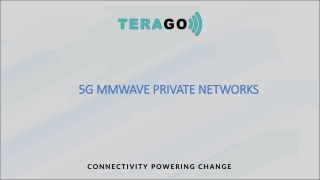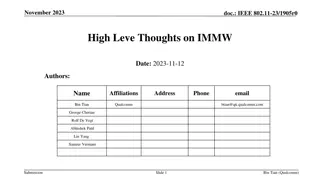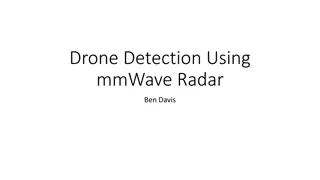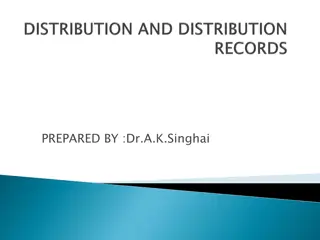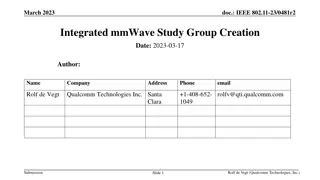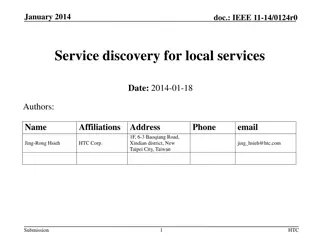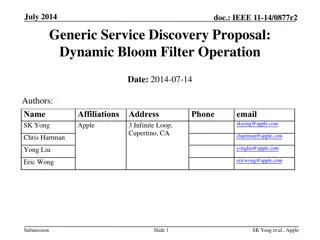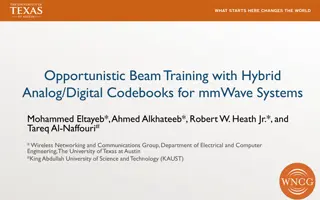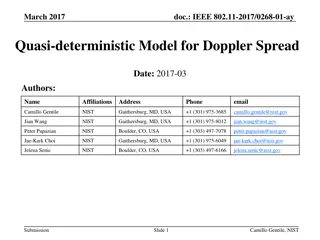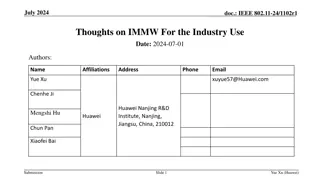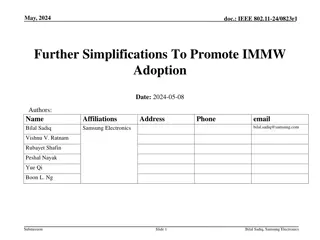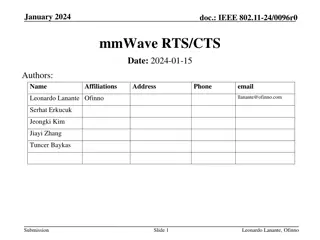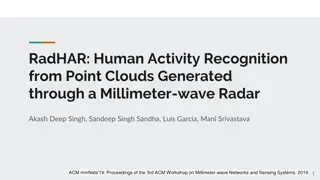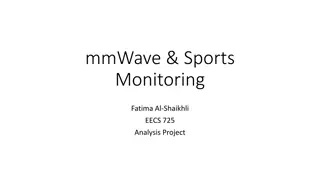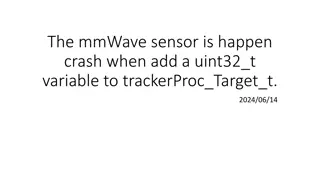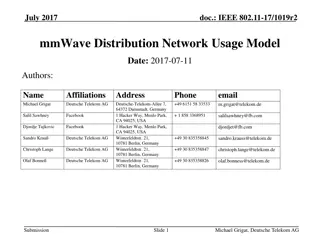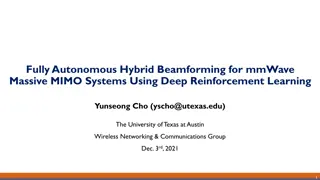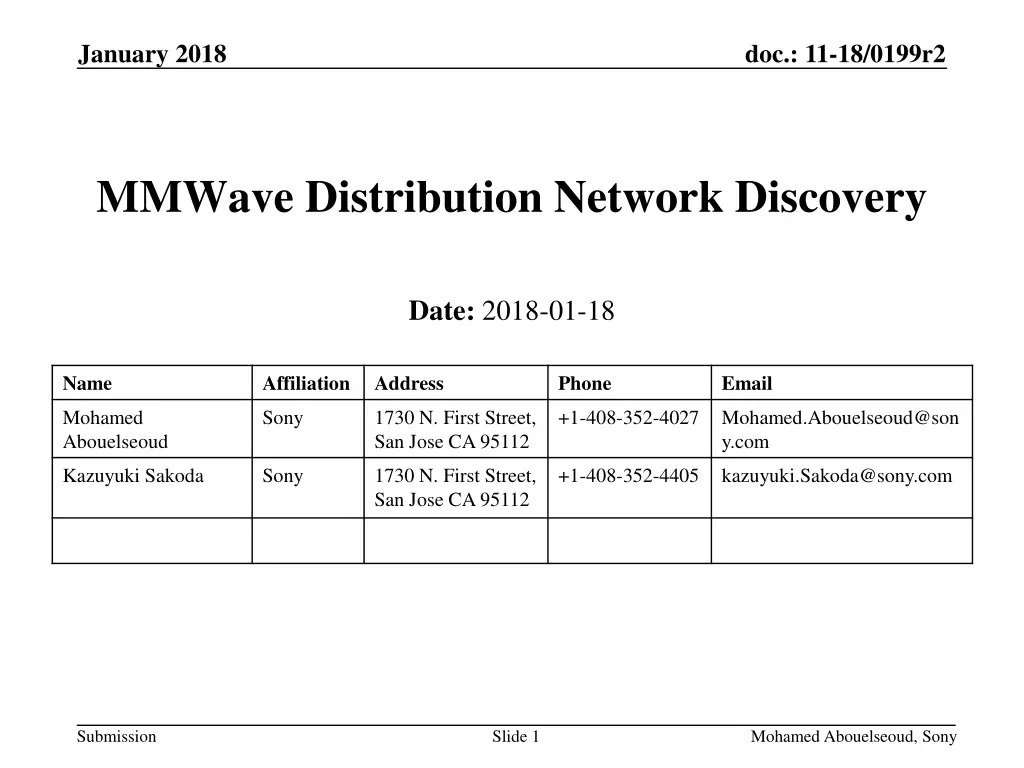
MMWave Distribution Network Discovery in January 2018
Explore the detailed presentation on MMWave Distribution Network Discovery from January 2018, covering topics like trigger mechanisms, new node joining processes, and benefits of TDD-mode in consumer devices for reducing latency and enhancing flexibility in network scheduling.
Download Presentation

Please find below an Image/Link to download the presentation.
The content on the website is provided AS IS for your information and personal use only. It may not be sold, licensed, or shared on other websites without obtaining consent from the author. If you encounter any issues during the download, it is possible that the publisher has removed the file from their server.
You are allowed to download the files provided on this website for personal or commercial use, subject to the condition that they are used lawfully. All files are the property of their respective owners.
The content on the website is provided AS IS for your information and personal use only. It may not be sold, licensed, or shared on other websites without obtaining consent from the author.
E N D
Presentation Transcript
January 2018 doc.: 11-18/0199r2 MMWave Distribution Network Discovery Date: 2018-01-18 Name Affiliation Address Phone Email Mohamed Abouelseoud Sony 1730 N. First Street, San Jose CA 95112 +1-408-352-4027 Mohamed.Abouelseoud@son y.com Kazuyuki Sakoda Sony 1730 N. First Street, San Jose CA 95112 +1-408-352-4405 kazuyuki.Sakoda@sony.com Submission Slide 1 Mohamed Abouelseoud, Sony
January 2018 doc.: 11-18/0199r2 Agenda Introduction Problem description OOB discovery trigger: what is available in the spec? Potential solution Conclusion Submission Slide 2 Mohamed Abouelseoud, Sony
January 2018 doc.: 11-18/0199r2 Introduction (1) mmW access link mmW distribution link Small cell ` mmW DN Provider Network Wi-Fi AP Fiber PoP (cabinet) fiber mmWave DN mmWave link WTTH Small cell Use case c) WiFi AP / SC Use case a) WTTH Use case b) WTTB WTTH Wi-Fi- AP RGW Alternative: Wireless inhouse TDD mode is introduced for Distribution Network, it can be attractive even for consumer devices [2] Home (indoors) distribution network like topology provides more reliable connections New STA onboarding to a TDD-mode Distribution Network is triggered by OOB signaling [3] If we consider to adopt TDD mode to consumer devices and use cases other than Usage Model 10 in [4], onboarding trigger procedure should be specified in the standard Submission Slide 3 Mohamed Abouelseoud, Sony
January 2018 doc.: 11-18/0199r2 Introduction (2) Trigger sector sweep New node Joining No/reduced BHI Need to reduce possible latency due to BHI and beamforming exchange Exhaustive sector sweep beacon transmission every BI affects the latency and introduces interference New node joining the network is an event that occasionally happens Only perform the exhaustive sector sweep when a new node is joining the network Submission Slide 4 Mohamed Abouelseoud, Sony
January 2018 doc.: 11-18/0199r2 Introduction (3) Why TDD-mode in consumer devices? Reduce latency by the removal of BHI Reduce channel blocking for beamforming by distributing the beamforming frames across the scheduled slots Add more flexibility for scheduling by controlling the slots structure and size Submission Slide 5 Mohamed Abouelseoud, Sony
January 2018 doc.: 11-18/0199r2 Problem description (1) A new STA joining to an existing Distribution Network will take the following steps [3]: 1. System Admin scans Bar-code of the new STA and transfer the information using out-of-band (OOB) signals 2. The message is transferred to DMG STAs nearby through a controller Controller Provider Network Fiber PoP (cabinet) STA A fiber mmWave DN mmWave link STA B New STA STA-A and New STA exchange beamforming frames, starts authentication and association STA-B and New STA repeats the same sequence A proper discovery trigger signaling enables successful onboarding of a new STA to TDD mode network is needed to enable the use of TDD mode for consumer devices. 3. 4. Submission Slide 6 Mohamed Abouelseoud, Sony
January 2018 doc.: 11-18/0199r2 mmW discovery trigger: what is available in the spec (1) 802.11ad introduced Multi-Band operation MB capability should allow off-60GHz signaling Submission Slide 7 Mohamed Abouelseoud, Sony
January 2018 doc.: 11-18/0199r2 mmW discovery trigger: what is available in the spec (2) Close look on Multi-Band operation Multi-band capable device can manage operation over more than 1 frequency band/channel MM-SME can share information among STAs in the same device RSNA security credentials can be shared among STAs in the same device FST can be set up if necessary OCT is available to carry 60GHz management messages via sub 6GHz Submission Slide 8 Mohamed Abouelseoud, Sony
January 2018 doc.: 11-18/0199r2 mmW discovery trigger: what is available in the spec (3) It looks like there are plenty of tools to enable 60GHz discovery trigger using 802.11 protocols, if we can assume DMG STA is Multi-Band capable Submission Slide 9 Mohamed Abouelseoud, Sony
January 2018 doc.: 11-18/0199r2 Potential solution Option 1: Define Public action frame exchange in sub-6GHz New STA transmits Discovery Trigger Request Action to neighboring STAs Neighboring STAs respond with Discovery Trigger Response Action , and kick the TX SLS equivalent signaling on the 60GHz channel Option 2: Signal MB and 60GHz on-demand sector sweep capabilities via Beacon/Probe Response in sub-6GHz Optional RSNA set up in sub-6GHz Use On-Channel Tunneling on the sub-6GHz channel to kick TX SLS equivalent signaling on the 60GHz Option 3: Something else, there should be many other ways to make it happen Submission Slide 10 Mohamed Abouelseoud, Sony
January 2018 doc.: 11-18/0199r2 Conclusion Discovery trigger scheme for TDD mode distribution network should be defined in the standard Use of Multi-Band capability looks to be easy and feasible solution 2 options to enable discovery triggering leveraging existing Multi-Band capability are presented Submission Slide 11 Mohamed Abouelseoud, Sony
January 2018 doc.: 11-18/0199r2 Straw poll (1) Do you think additional signaling for discovery triggering is needed for the TDD mode described in [*] to support consumer devices? Yes No Need more information Don t care [*] IEEE 802.11-17/1321r0 Features for mmW Distribution Network Use Case , Djordje Tujkovic, et.al Submission Slide 12 Mohamed Abouelseoud, Sony
January 2018 doc.: 11-18/0199r2 Straw poll (2) Do you think the use of Multi-Band operation would be feasible approach for off-60GHz discovery signaling? Yes No Need more information Don t care Submission Slide 13 Mohamed Abouelseoud, Sony
January 2018 doc.: 11-18/0199r2 Straw poll (3) Which of the options described would you prefer? Option 1 Option 2 Need more information Don t care Submission Slide 14 Mohamed Abouelseoud, Sony
January 2018 doc.: 11-18/0199r2 References [1] Draft P802.11ay D1.0 [2] IEEE 802.11-18/194r1, Distribution network use case for consumer devices , Kazuyuki Sakoda, et.al. [3] IEEE 802.11-17/1321r0 Features for mmW Distribution Network Use Case , Djordje Tujkovic, et.al. [4] IEEE 802.11-15/625r7 IEEE 802.11 TGay Use Cases , Rob Sun, et.al. Submission Slide 15 Mohamed Abouelseoud, Sony
January 2018 doc.: 11-18/0199r2 Backup Discovery Trigger Action Frames Sub-6GHz New STA Sub-6GHz DN STA Sub-6GHz New STA Sub-6GHz DN STA MB discovery trigger Req Beacon With MB IE MB discovery trigger Resp Intiate mmW MLME Intiate mmW MLME MB discovery trigger Req MB discovery trigger Resp Intiate mmW MLME Intiate mmW MLME Submission Slide 16 Mohamed Abouelseoud, Sony
January 2018 doc.: 11-18/0199r2 Backup Sub-6GHz On-Channel Tunneling New Node DN Node mmW MLME Sub-6GHz MLME mmW MLME Sub-6GHz MLME MLME- OCTunnel.req (tunneled Discovery trigger Req frame ) On-Channel Tunnel Request frame MLME- OCTunnel.ind (tunneled Discovery trigger Req frame ) (tunneled Discovery trigger Req frame ) MLME- OCTunnel.req (tunneled Discovery trigger Resp frame ) On-Channel Tunnel Request frame MLME- OCTunnel.ind (tunneled Discovery trigger Resp frame ) (tunneled Discovery trigger Resp frame ) Initiate mmW discovery Initiate mmW discovery Submission Slide 17 Mohamed Abouelseoud, Sony
January 2018 doc.: 11-18/0199r2 Device Provisioning Protocol (DPP) New STA AP Wi-Fi Alliance defined protocol Provides a secure method for on- and off-boarding devices with limited user interface on a Wi-Fi network. AP discovery and STA scanning are beyond what DPP is offering DPP Scanning Authentication Association Submission Slide 18 Mohamed Abouelseoud, Sony

